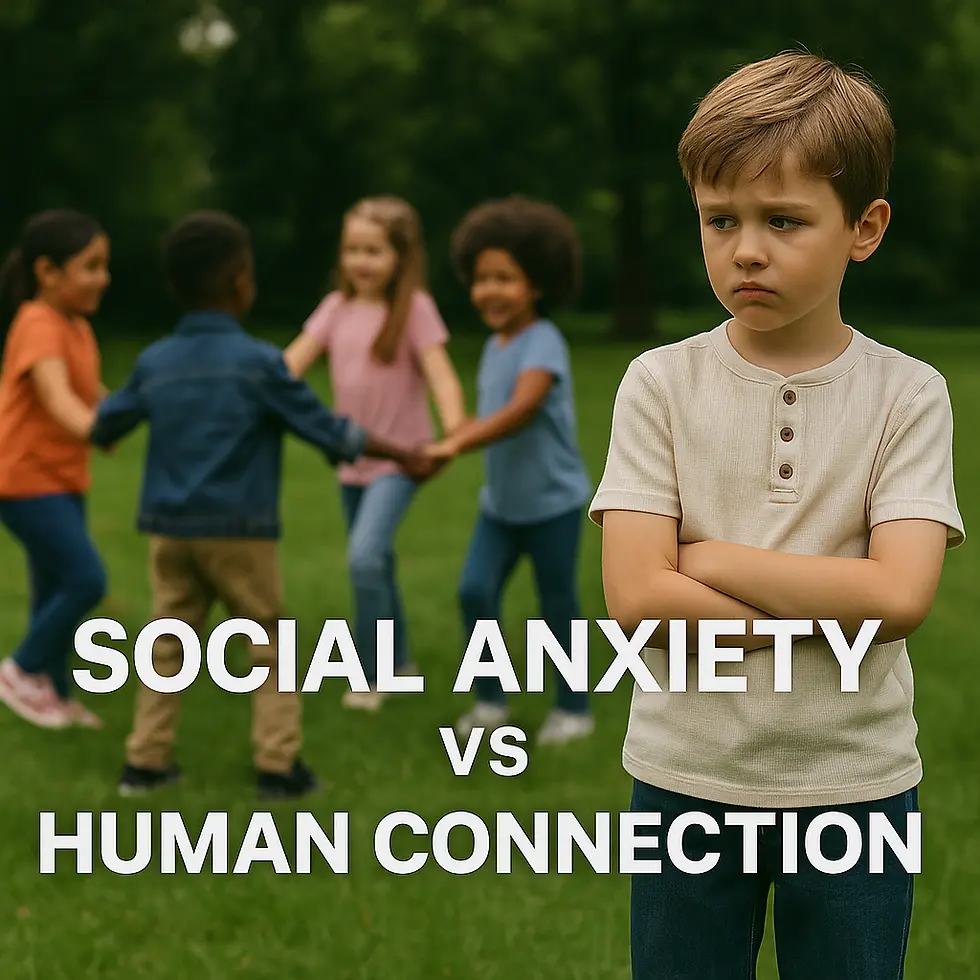Social Anxiety & Depression
- Jason T

- Jul 17
- 5 min read
Updated: Jul 22

Social Anxiety, Depression & the Power of Human Connection
Even AI wouldn’t work without social interaction—we need each other to thrive, no matter our age.
Why this matters: As nursing students, understanding the interplay between social anxiety and depression gives you the ability to detect early warning signs in patients who may not explicitly express emotional distress. These mental health issues often go unspoken, yet they deeply influence outcomes like medication adherence, treatment participation, and healing. Learning to recognize subtle cues of social discomfort can allow you to intervene earlier and refer appropriately.
1. Understanding Social Anxiety & Social Depression
Social anxiety is an intense fear of social situations—leading to avoidance that impairs daily life and relationships.
Social depression often arises from prolonged isolation—lack of meaningful connection fuels symptoms like low mood, fatigue, and hopelessness.
These conditions can reinforce each other: anxiety reduces socializing, isolation deepens depression.
Why this matters: As future healthcare providers, you'll encounter patients whose emotional pain may manifest physically—headaches, fatigue, GI issues, and more. Understanding the social roots of these symptoms allows for more holistic care. Recognizing this cycle empowers you to advocate for social prescribing and inter-professional mental health supports that address root causes rather than symptoms alone.

2. Why Social Interaction Is Vital Across Lifespans
Children need peer play to learn empathy, communication, and problem-solving.
Adolescents define their identity and emotional intelligence through peer interaction.
Adults require consistent social engagement for stress reduction, improved immunity, and emotional regulation.
Elderly benefit from companionship and structured interaction to maintain cognitive function and reduce the risk of depression and physical decline.
Why this matters: Nursing care spans the entire lifespan—from pediatric assessments to geriatric support. When you understand the social needs of different age groups, you can identify when a patient's health issue might be rooted in unmet social connection. This awareness strengthens your patient assessments and makes your care more person-centered and preventative.
3. Recognizing the Need for Socialization
Life Stage | Warning Signs | Why It Matters |
Children | Less play, language delay, detachment | Social learning impacts emotional maturity and school success |
Teens | Peer withdrawal, mood shifts, academic drop | Peak onset age for mental health disorders |
Adults | Isolation, job burnout, low energy | Tied to increased risk of chronic diseases |
Elderly | Cognitive decline, disinterest, complaints | Social isolation is linked to early mortality and dementia |
Why this matters: These warning signs may be subtle but are often the first indicators of deeper health issues. For nursing students, knowing what to look for ensures you can catch at-risk individuals before a crisis emerges. It trains you to see the whole person, not just the presenting symptoms, and to understand how a patient's environment influences their well-being.

4. Supporting Social Health: A Guide for Nursing Students
Children benefit from structured play and caregiver modeling.
Teens gain emotional skills through mentorship and peer support.
Adults need outlets for stress and connection in high-pressure roles.
Elders thrive in programs that foster purpose and shared experience.
Why this matters: You are not just treating illness—you’re helping patients build the kind of life that supports health. Supporting social connection may mean suggesting a walking group for a lonely senior or referring a struggling teen to a support circle. These simple, human-centered suggestions often yield better results than medication alone.
5. Nursing Interventions & Best Practices
Therapy referral, CBT, and structured group support offer tools to manage anxiety and reconnect.
Social prescribing integrates community and social care directly into treatment plans.
Tech literacy empowers the isolated to connect in safe, meaningful ways.
Routine screening ensures social health isn’t overlooked in assessments.
Why this matters: Modern nursing blends evidence-based medical practice with an understanding of human behavior. By integrating social health into your assessments and care plans, you elevate the standard of nursing care. It also helps you foster trust with patients—when they feel seen, heard, and connected, they’re far more likely to engage with their own healing.
🌿 Reconnect Through Real-World Activities
Beyond setting digital boundaries, nursing students can recommend intentional physical activities that promote bonding and reduce reliance on screens. Encourage families to take a walk together after dinner, work in the garden, play outdoor games, or explore a new trail in their community. Even indoor activities like board games or puzzle nights can foster communication, laughter, and teamwork—essential components of social wellness. These moments help families reconnect with each other while disconnecting from the constant pull of the virtual world, reinforcing a sense of presence, emotional security, and mental refreshment for both children and adults.
💡 Ready to Get Certified? Its a social event!
Be prepared. Be confident. Learn First Aid Today & Save a Life Tomorrow with Saving Grace Medical Academy Ltd. Now enrolling: Basic Life Support (BLS) & Standard First Aid CPR-C & AED courses designed for healthcare professionals.
📍 Training for First-Year Nursing Students
Join Saving Grace Medical Academy Ltd. for fully certified, CSA-compliant Standard First Aid CPR-C & AED courses—designed for Alberta’s future healthcare professionals.
Just Remember:
Protect Yourself. Call 911.Don’t Waste Time.
RESOURCES:
Advanced Cardiovascular Life Support - Heart & Stroke Foundation
Basic Life Support BLS- CPR Course 09:00am | Saving Grace Medical
Advanced Cardiovascular Life Support Course | Saving Grace Medical
Physical Activity & Sedentary Behaviour - HP | Alberta Health Services
Province-Wide Mental Health Support for Albertans with Togetherall | Togetherall
Mental Health for Children and Families - CASA Mental Health

Author - Saving Grace Medical Academy Ltd
Jason T
Retired EMT - Heart & Stroke Foundation Senior Instructor







